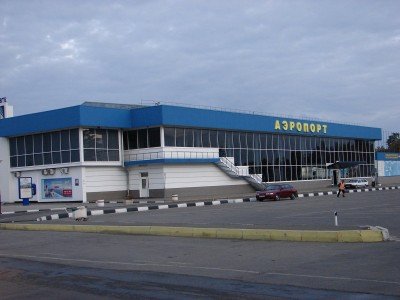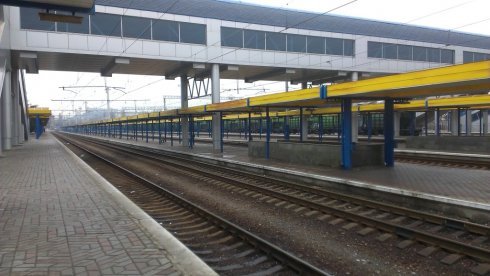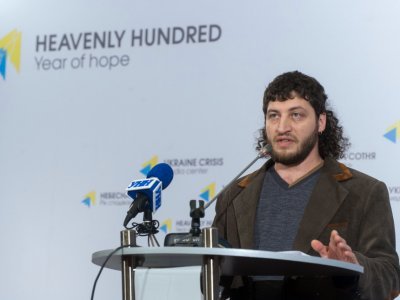Sergey Marchenko
Ukrainian sanctions against Crimea

The Simferopol airport
Air communication between mainland Ukraine and Crimea was stopped when “men in green” have occupied Crimean airports. In March, Kiev officially closed the airports of Crimea. In accordance with the UN resolution on non-recognition of results of the Crimean “referendum”, the ICAO (International Civil Aviation Organization) continues to consider Crimea as the territory of Ukraine, which is responsible for flying across the peninsula. As Ukrainian airline services were unable to ensure security in this region, the peninsula became a no-fly zone. Now only Russian airline companies conduct flights to Crimea and, by doing so, they violate the international air law.
In spring of 2014, Crimea didn’t get the Dnieper water in the North-Crimean channel for the first time since its opening.
In 2014, Crimean trade ports (in Yalta, Kerch, Evpatoria, Sevastopol and Feodosia) were closed for shipping, and in April 2016, the Cabinet of Ministers decided to close two fishing ports – in Sevastopol and Kerch.
Since most countries in the world don’t recognize the annexation of the peninsula, Crimean ports became available only for the Russian domestic shipping as well as those vessels that ignore the ban. However, there are fewer and fewer these offenders every year.

Empty train station in Simferopol
Railway and bus transportation to the peninsula was stopped at almost the same time at the end of December of 2014.
The only resource that Ukraine continued to provide Crimea with was electricity supplied to the occupied peninsula on the basis of a contract between the Ukrainian state enterprise “Ukrinterenergo” and the Russian enterprise “Inter RAO”.
However, after the start of the trade blockade of the peninsula in autumn of 2015 and the destruction of transmission towers by explosive demolition in the Kherson region, the question of signing up for the contract’s duration moved to a new level. Ukraine declared its readiness to supply electricity only to the temporarily occupied territory of the Autonomous Republic of Crimea, but of course, Russia couldn’t take this step. For this reason, Crimea was left without Ukrainian electricity.
Thus, the peninsula is almost completely isolated from mainland Ukraine. Today there are only road connections, but after the Russian procedure of re-registration of Ukrainian car numbers, most Crimeans can’t leave the peninsula – Ukraine doesn’t recognize the documents issued by occupation authorities.
Criminal cases against traitors and collaborators
 From the first days of the peninsula’s occupation, there is a list of persons involved in the establishment of the Russian control over the peninsula available in Ukraine. One of the first criminal proceedings was opened against the Crimean “prosecutor” Natalya Poklonskya appointed by occupants under Art.109 of the Criminal Code of Ukraine. She is suspected of committing the actions taken for the forced regime change or overthrow of the constitutional order or seizure of state power. At the same time, it is impossible to open a similar criminal case against the “head” of Crimea Sergey Aksenov, because international lawyers consider this step as political repression.
From the first days of the peninsula’s occupation, there is a list of persons involved in the establishment of the Russian control over the peninsula available in Ukraine. One of the first criminal proceedings was opened against the Crimean “prosecutor” Natalya Poklonskya appointed by occupants under Art.109 of the Criminal Code of Ukraine. She is suspected of committing the actions taken for the forced regime change or overthrow of the constitutional order or seizure of state power. At the same time, it is impossible to open a similar criminal case against the “head” of Crimea Sergey Aksenov, because international lawyers consider this step as political repression.
“Interpol thinks that it is a kind of political repression. For example, public prosecution bodies couldn’t put the “head” of Crimea on the wanted list based on high treason. In other words, we have to prove that a person has committed a criminal offense while being not involved in military crimes and any political offences but just in criminality,” the deputy prosecutor of the Autonomous Republic of Crimea Petr Kovalenko explained.
Therefore, a criminal case based on the embezzlement of public property was opened against the Crimean “prime minister” (appropriation and transfer of property of the Ukrainian State Enterprise “International Children’s Center “Artek” to the Russian Federation).

“Director” Yanina Pavlenko with Vladimir Putin and Silvio Berlusconi
In 2015, Ukraine prepared a sanctions list containing the most active supporters of the Russian occupation starting from the head of the Sevastopol city council Yuriy Doynikov to the former head of the Sevastopol fishing port Vyacheslov Rumyantsev. The acting “Director General” of the Massandra winery Yanina Pavlenko, who is famous for her pro-Russian actions while being the defendant in criminal proceedings based on the fact of opening the collector’s bottle priced at $100 000 for the Russian President Vladimir Putin and his Italian friend, ex-Prime Minister Silvio Berlusconi, was included to this list.
The General Prosecutor Office of Ukraine charged 326 Crimean judges, who started to work in Russian courts on the peninsula, of high treason. On April 19, the Verkhovna Rada of Ukraine dismissed 193 judges of Crimean courts violated their oath and this fact opens up opportunities for their criminal prosecution.
Moreover, the General Prosecutor Office opened criminal cases against 413 former prosecutors of the Autonomous Republic of Crimea charged with high treason. Criminal proceedings were opened against the Crimean tax service employees, who started to work in the occupation authorities.
More than 3,000 Ukrainian soldiers who stayed in occupied Crimea are suspected of treason and desertion. Some of them have been already arrested while visiting mainland Ukraine and convicted.
In March 2016, the State Security Service of Ukraine published a list of 1391 employees who violated their oath and deserted to enemy in Crimea and Sevastopol.
The Prosecutor Office of the Autonomous Republic of Crimea also started criminal investigation on nationalized Ukrainian property in Crimea, which is now sold out by occupants, such as for instance Massandra vineyards.
Calculation of damages and claims to international courts
Ukraine doesn’t still clearly determine the amount of damage to the state caused by the annexation. Indeed, it is not easy to do this. If it is possible to calculate the damage from the loss of enterprises by taking into account their value and income, then it is difficult to estimate the loss of the Chersonesos Taurica or the Aivazovsky Art Gallery.
However, in general, the losses of Ukraine caused by the annexation of Crimea have been already calculated on a number of positions and they are estimated at more than 1 trillion hryvnas (about 40 billion dollars). The amount of damage resulting from the loss of Ukrainian enterprises in Crimea is in the range of 1 billion hryvnas.
Ukraine as well as its legal entities and individuals are going to recoup their losses in international courts.
 For example, on April 20, the NJSC Naftohaz of Ukraine filed a lawsuit for its property lost in Crimea in the international court. According to the holding company’s director Andrey Kobolev, the amount of damage includes not only the price of oil derricks but also “the value of all assets lost by Naftohaz in Crimea because of the Russian occupation or those assets that we temporarily don’t have any access”. Naftohaz estimated the total loss at 15.7 billion hryvnas.
For example, on April 20, the NJSC Naftohaz of Ukraine filed a lawsuit for its property lost in Crimea in the international court. According to the holding company’s director Andrey Kobolev, the amount of damage includes not only the price of oil derricks but also “the value of all assets lost by Naftohaz in Crimea because of the Russian occupation or those assets that we temporarily don’t have any access”. Naftohaz estimated the total loss at 15.7 billion hryvnas.
Oschadbank that couldn’t take a significant amount of money and about 300 kg of gold out of occupied Crimea also joined to the legal proceedings against the Russian Federation. The provisional amount of damage voiced by Oschadbank is estimated at 670 million dollars.
The Ministry of Justice of Ukraine filed a number of claims on behalf of the Ukrainian state. For example, the lawsuit for illegal use of the continental shelf of Ukraine by Russia. According to estimates of the Ministry of Justice, in spring of 2014, the amount of damage was 950 million hryvnas, but with the US dollars exchange rate growth, this amount has increased a lot.
 As of today, the Ministry of Justice filed 4 lawsuits to the European Court of Human Rights (the fifth one is coming soon), where the claims on Crimea and Donbass against the Russian Federation were combined. In addition, several hundred individual claims of Ukrainian citizens on issues of occupation of Crimea and the war on Donbass are pending before the ECtHR.
As of today, the Ministry of Justice filed 4 lawsuits to the European Court of Human Rights (the fifth one is coming soon), where the claims on Crimea and Donbass against the Russian Federation were combined. In addition, several hundred individual claims of Ukrainian citizens on issues of occupation of Crimea and the war on Donbass are pending before the ECtHR.
The head of the Ukrainian Helsinki Human Rights Union’s Advocacy Centre Boris Zakharov believes that Ukraine has all chances to get positive ECtHR’s judgements, although the examination of these claims may take years.
“I believe that all of these claims are promising, but the only problem is the timing, We have all chances to win lawsuits under articles on disappearances, tortures, restriction of freedom of movement, violation of religious rights, when undesirable confessions have been closed, and many claims for property rights. Moreover, there are issues of discrimination on ethnic and religious grounds. The state claims are also promising since they are related to illegal actions of Russia undermining the system of international law and world order,” Zakharov says.
The Ukrainian oligarch Igor Kolomoyskiy who estimated his losses in Crimea at 2 billion dollars, including about 1 billion dollars for lost PrivatBank’s assets also submitted a claim to international courts.
In other words, Ukraine is slowly but surely on the way of collecting evidences to punish the aggressor in international courts. It is difficult to say to what extent it brings us closer to the de-occupation process. Probably, these measures are not enough, but Ukraine doesn’t see no other way now.
In spite of solemn assurances that “Crimea was, is and will be Ukrainian”, which we regularly hear from Ukrainian politicians, the state policy of Ukraine is aiming largely at distancing from the peninsula and shifting the responsibility to the country-occupant. The lack of a strategy and mechanisms to get Crimea back shows that today the country is simply not ready to start the de-occupation process. When the time comes, there will be both forces and capabilities.












